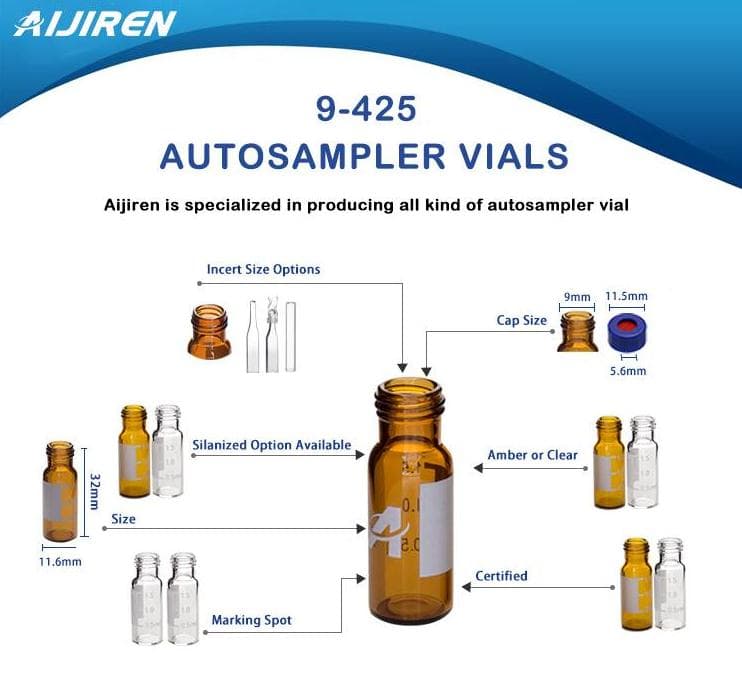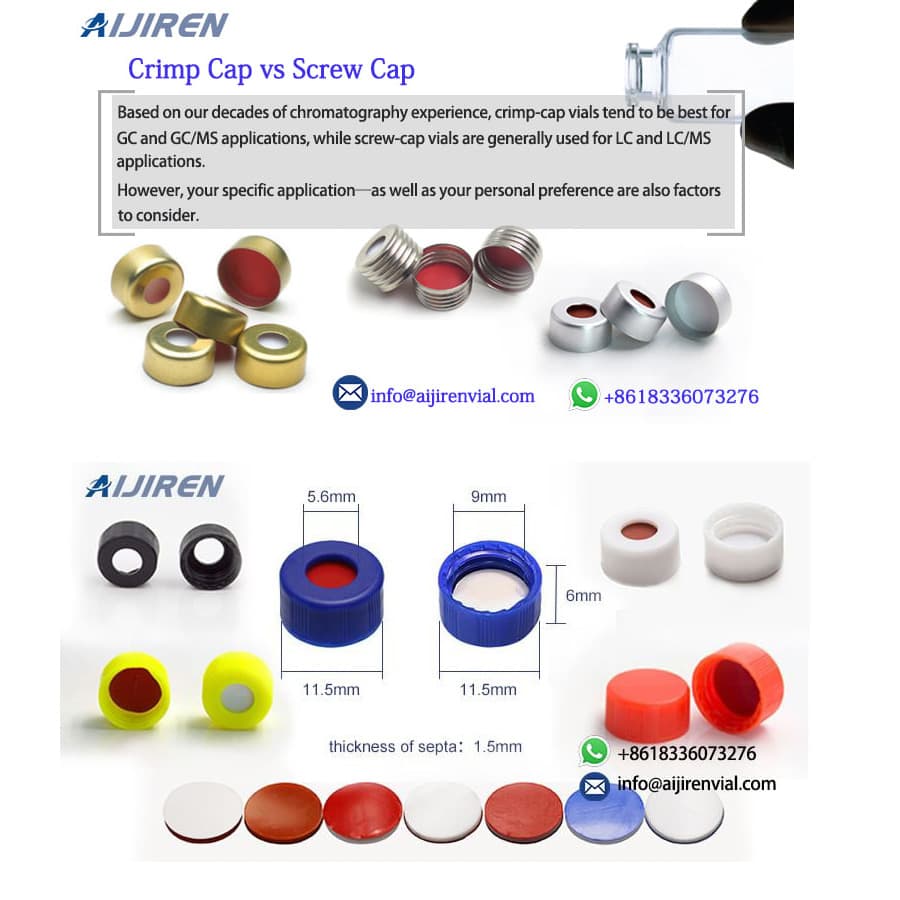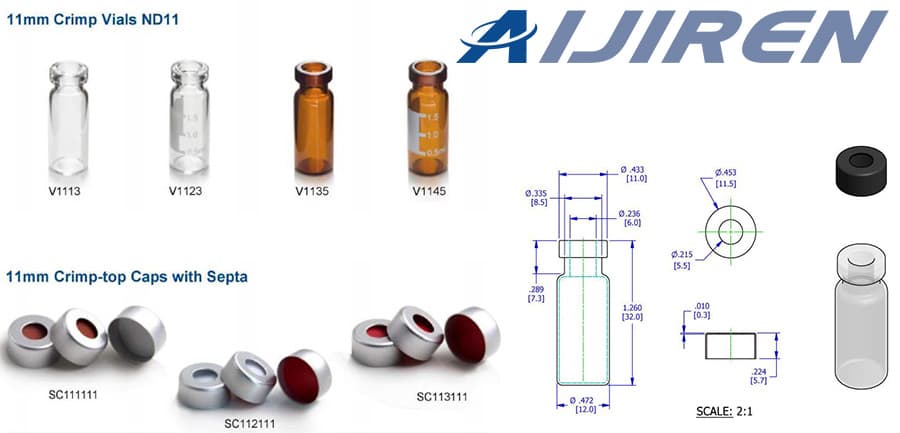Apr. 14th, 2022
Chromatography vials are typically used as temporary sample containers for subsequent gas chromatography (GC) or liquid chromatography (LC) analysis. Consider these factors when choosing the correct vial for your applications.
1) Check your autosampler for compatibility
If you are using an autosampler, be sure to confirm compatibility with the manufacturer's requirements before referencing this guide.There are hundreds of models of autosamplers available, each with its own purpose and specifications for use. Some use robotic arms to pick up the vial while others rotate the tray and align the sampling needle to the vial.
Standard chromatography vial sizes include 8 x 40mm, 12 x 32mm, and 15 x 45mm. Robotic Arm Machines (R.A.M.) use a non-standard 9mm vial with a magnetic cap. For autosamplers, choose a vial designed for that specific brand.Most autosamplers require a very specific vial size and the closure type for proper usage. If the wrong type of vial is used with your autosampler, this could result in mechanical damage.

2) Select the vial material
Vials are either made from glass or plastic.Glass is a common choice for most labs since it is pure and more heat resistant than plastic. Type I Borosilicate glass tends to be a better option for higher-end laboratories testing PH-sensitive samples due to its highly resistant composition.
Plastic vials can be used to provide higher chemical resistance and lighter weight construction. Plastic vials can also be used for samples that are sensitive or stick to glass. As an added bonus, plastic vials tend to have higher durability and are usually more affordable.
However, not all plastic vials are created equal so be sure to check the type of plastic used. Polypropylene is by far the best option for plastic vials due to its good chemical resistance for short-term storage. They can also be incinerated while sealed limiting exposure to hazardous materials.
Glass Autosampler Vials
The most common type of Autosampler vial is the Type 1 Borosilicate Glass, which represents the least reactive glass. Type 1 glass has the least pH shift (lowest leaching characteristics) and a Coefficient of Expansion = 33 for Clear and 51 for Amber
Plastic Autosampler Vials
Plastic vials are an economical option when you need a limited volume vial. Plastic Vials are most often Polypropylene (PP). Polypropylene Vials are compatible with Acetone, Ethyl Acetate, Methanol, Isobutyl alcohol, methanol, and methyl ethyl ketone. They are incompatible with cyclohexane, ethers, dichlorobenzene, pentanes, methylene chloride, and trichlorobenzene.

3) Consider your sample size
There are many different sizes available for vials depending on the type of vial chosen. You should determine the size of your sample upfront and confirm the working volume of the vial prior to purchase. The most common sizes for vials include 1ml, 2ml and 4ml.
4) Select the proper closure
Chromatography vials typically have crimp, snap, or screw finishes. Closures may be pre-assembled with septa or the septa purchased separately. Vials with closures are also sometimes sold in pre-assembled sets.
Crimp top finishes are used with aluminum crimp seals to create a more permanent closure. Choose a flat finish or use a beveled finish for a tighter seal.

A snap finish accommodates a cap that is more easily applied and removed. Some vials have a finish that can be used with either crimp-top or snap closures.
Both snap and screw closures are usually made from plastic (polyethylene, PP, or a phenolic resin). They are available in a range of colors and sizes. The size of screw thread closures is typically expressed as two numbers that represent the diameter and the standard thread finish. For example, a closure size of 28-430 indicates a diameter of 28mm and a 430 GPI thread finish
5) Working with light-sensitive samples?
Aijiren Tech amber chromatography vials are strongly recommended. Amber glass is formulated to absorb light in the ultraviolet region of the electromagnetic spectrum and therefore provides excellent protection for your valuable samples.
6) Check the quality of the vials
Oftentimes, you are dealing with tiny amounts of a sample that needs to be measured as accurately as possible. Additionally, you may have strict requirements for inertness and cleanliness.
Regardless, it is critical to minimize the risk for contaminating or comprising the sample. Ensure the products you purchase have a quality certification such as ISO9001:2015 and validate the processes for which the vials and any related accessories such as septa or inserts are produced.
Check to ensure the vial manufacturer has policies for cleanroom production and R&D/Quality Control measures in place. Experienced technicians should be auditing products to ensure the highest possible quality.

7)Determine a consistent method for labeling
Many vials come with writing areas for easy labeling. Consider this writing patch option if you don't have an automatic or manual label printer. Either way, you'll want to plan a system for labeling prior to sampling so you can easily find samples and know exactly what they are.
8)What are the most common vial styles for chromatography?
All Aijiren Tech chromatography vials are made from clear or amber borosilicate glass, which conforms to USP Type I and ASTM E438, Type I, Class B requirements.
Two types of applications:
HPLC: The most common vial sizes for liquid chromatography vials are 12 x 32 mm as well as 15 x 45 mm. 12 x 32 mm vials will also be described as 1.5 mL, 1.8 mL, or 2.0 mL vials.
GC: Vials for gas chromatography (headspace vials) are available in different sizes and come with a crimp or screw finish. Headspace vials are available with a flat and rounded bottoms. The rounded bottom is sturdier and therefore more resistant to the high pressure which builds up inside the vial during the heating process.
Your Additions are Welcome for More Factors to Choose Chromatography vials .
What to Pay Attention To
Be mindful of all of the critical criteria when selecting a chromatography vial for analysis, such as its type, desired sample volume, compatibility with solvents and closure options, material composition and surface treatment as well as inertness, precision, and reliability in resistance to breakage - ease of use is also a consideration for cost effectiveness! Other essential criteria to keep in mind include regulatory compliance certification reputation of the manufacturer customer reviews technical support supplier reliability delivery time as well as overall suitability with your specific analysis needs for accurate and reliable results.
Contact us now
If you want to buy Chromatography vials&closures of Aijiren, please contact us by the following five ways. We will reply to you as soon as possible.
1.Leave a message in the form below
2.Contact our online customer service at lower right window
3.Whatsapp me directly: +8618057059123
4.Mail me directly:market@aijirenvial.com
5.Call me Directly:8618057059123


 English
English
 Chinese
Chinese




